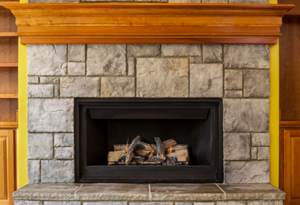Make Your Chimney More Efficient
Here’s How
As we ever so slowly turn towards Fall, it is time to discuss heating efficiency. As you know, time flies, and weather changes happen quickly in New England.
Traditional masonry fireplaces may make your home cozy, and we love the smell of wood burning. But there are alternatives and measures we can take to improve efficiency. Here are ways to maximize your chimney’s heating efficiency this coming winter.
Wood Stoves
Modern wood stoves are very good at generating heat for a home. Wood-burning stoves are designed to be much more efficient than traditional open fireplaces. Wood stoves have official efficiency ratings of between 70% and 80%, while open fireplaces can be as little as 10% efficient.
Install a Gas Insert to Increase Heating Efficiency
A gas insert is a factory-built unit that, in many ways, is like a fireplace in a box. The insert is made to fit directly into the open firebox of your masonry fireplace and is connected to its own vent system, which is run up through the existing chimney.
Gas-fueled fireplace inserts are ultra-safe and high-performing. Heavy insulation and closed-combustion technology mean you will get great heat in an appliance that meets all EPA regulations and runs safely and predictably, winter after winter.
Install a New Chimney Liner
Liners are typically installed to ensure a safe passageway for the flue gasses in the chimney, but did you know that they also improve energy efficiency? Not only are they a safety precaution but having a properly sized venting system for your heating equipment optimizes efficiency. Think of it as a straw with a hole in it – cracks within the flue liner can cause excess air and gases to escape within the walls of your chimney and put you and your family at risk.
Burn Seasoned Firewood
Fresh wood has a high moisture content. After all, trees need a constant supply of water to grow. The high moisture content makes for a smokier fire that generates less heat and burns quickly. Instead, source seasoned firewood that has been dried for at least six months. The lower moisture content will burn slower at higher temperatures with less smoke and soot for a more efficient fire-burning experience.
Close the Damper
The damper is a metal device that keeps air, moisture, and debris out of the firebox when the fireplace is not being used. But forgetting to close the damper after the fire is out like leaving a window open, and all the heat that was generated will go out the chimney. Close the fireplace damper when the fire is completely extinguished will retain the heat in the firebox and continue to warm your living space for several hours. Making sure your fireplace has a working damper will definitely help with keeping the energy in the house.
Install Glass Fireplace Doors to Reduce Heat Loss
Installing glass fireplace doors is an easy and practical way to increase your fireplace’s heating efficiency. Even though the damper must remain open to vent the exhaust when flames are present, closing the glass doors when the fire is smoldering will prevent the heated indoor air from being sucked into the fireplace. It will also help radiate the firebox’s heat throughout the living area.

